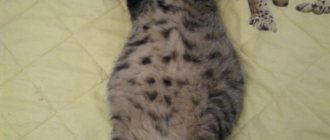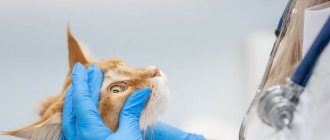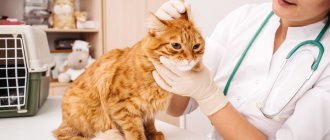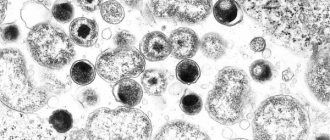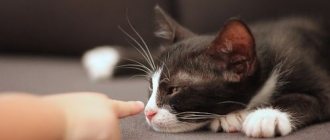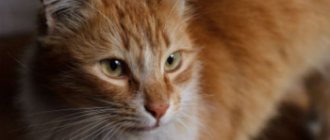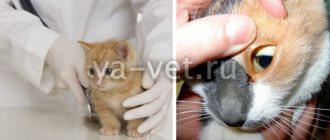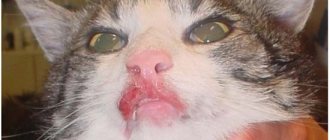Just like humans, pets often suffer from diseases that affect the visual organ. If you notice cloudiness in your pet's eye, increased tearing or swelling, you should immediately contact a qualified veterinarian for advice and help. This is due to the fact that the appearance of a cloudy film inside the eye may be evidence of the development of cataracts in a cat.
Cataracts are quite difficult to respond to therapeutic treatment methods, especially in advanced cases. As a rule, the main focus of conservative treatment is to alleviate the pet’s condition and prevent the development of complications.
With the development of cataracts, a cat may completely lose vision as a result of complete dysfunction of the lens. The very concept of cataract means clouding of a specific lens, transparent and clear under normal conditions, due to which a beam of light penetrating into the eye is refracted without distortion.
The lens in the eye is responsible for accurately transmitting images to the retina, where the brain processes information. Cloudiness of the lens provokes incorrect refraction of the light beam, the picture turns out to be very blurry, and sometimes does not reach the retina.
A cloudy lens causes a sick cat to not even see blurry objects, but only shadows. In addition, with the development of cataracts, inflammatory processes may appear against the background of a malfunction in the metabolic processes of the visual organ.
The pathological process leads to the beginning of the death of cellular structures and the breakdown of proteins located in the lens. The first signs of cataracts are not immediately noticeable, so the animal may suffer from the disease for a long time.
Content
1. Causes of occurrence 2. Risk groups 3. Varieties and forms 4. Stages of development 5. Treatment 6. Surgical treatment of the disease is represented by several types: 7. Prevention
Vision is of utmost importance for four-legged pets. Any negative processes associated with decreased visual acuity and complete loss of vision radically change the life of a pet and cause it many problems. Blindness is often caused by cataracts in cats or clouding of the eye lens, which serves as an important optical device. This phenomenon occurs under the influence of many factors. If you contact a professional veterinarian in a timely manner, the chances of saving your vision are quite high.
Description of ophthalmological disease: cataracts in cats
Nature has endowed cats with acute vision, but, unfortunately, like any other species of mammals, cats are not immune to various ophthalmological pathologies and diseases that can arise for one reason or another. Owners of furry cats should remember that the eyes are an indicator of the animal's health. That is why it is necessary to systematically examine the eyes of your pets and if any abnormalities or pathological clinical manifestations appear, immediately show the animal to a veterinarian.
It is worth noting that as ophthalmological diseases progress, irreversible processes may occur in the internal structures of the eye, which are the main cause of visual impairment and can even lead to atrophy of the optic nerve (blindness). One of these serious eye pathologies in cats is cataracts.
Causes
The lens forms the basis of the visual system of the four-legged pet's eye. It has the shape of a biconvex lens, which is necessary for refraction and proper focusing of visible light rays striking the retina. When organic and inorganic deposits accumulate in the tissues of the lens, the processes of cell degeneration are activated. This, in turn, provokes the gradual death of protein components and a change in the thickness of the lens capsule towards its increase. Epithelial cells accumulate on the surface of the lens, as a result of which the organ loses the ability to correctly refract the sun's rays. This means that the cat's cataracts are progressing.
Among all the possible causes of illness in pets, modern veterinarians identify the following:
| Natural aging | The lens can function fully only if it maintains a certain ratio of mineral and protein substances with water. An older pet's metabolism slows down and metabolic rates decrease. This provokes the accumulation of protein and fat deposits, calcium salts, cholesterol, and phosphorus on the surface of the lens. The level of fluid in the lens decreases markedly. |
| Injuries | Injuries leading to mechanical damage to the skull and organs of vision. Quite often, cataracts in a kitten develop as a result of a foreign body entering the visual system or bumping into hard objects. Clouding of the eye lens develops against the background of inflammatory processes progressing in the pet’s body. |
| Ophthalmology | Sometimes cataracts in cats are secondary in nature and are considered as a complication of an ophthalmological disease suffered by the animal. Malaise is caused by various forms of conjunctivitis, glaucoma, entropion of the eyelids, iridocyclitis, and eversion of the eyelids. |
| Hormonal disorders | Pet obesity, diabetes mellitus and urolithiasis are undesirable processes in which loss of vision can easily become a side effect. |
Ways to restore vision after surgery
Removing the lens does not mean that your eye will completely stop seeing. But the quality of vision will resemble the feeling when you open your eyes underwater. Orientation in space and the ability to perform simple actions are preserved, but the quality of life noticeably deteriorates.
After surgery, glasses, contact lenses, or intraocular lenses (IOLs) can replace the removed lens. For most patients, it is preferable to implant an artificial lens, which is installed instead of one removed immediately during surgical treatment. Glasses and contact lenses are used when the patient has contraindications to implant installation.
At-risk groups
The greatest attention to the problem of cataracts in cats, symptoms and treatment of the disease is paid to owners of elderly pets aged 8-9 years and older. The active development of senile cataracts occurs against the background of slow metabolism and the accumulation of large volumes of free radicals in the elderly body. Due to the pronounced oxidative effect, free radical molecules can destroy the finest structures of the organs of vision.
If we consider the breed's predisposition to the occurrence of this type of ailment, then the most frequently asked questions are whether cataracts can be cured in cats:
- Persian cats;
- Exotics;
- British;
- Scots.
This is due to the specific structure of the animal’s head, which affects the provision of sufficient nutrition to the tissues of the visual organs. It is surprising that mongrel creatures suffer from such deviations extremely rarely.
Diagnostic measures
If a kitten or an older animal has a cloudy lens in one eye or two visual organs at once, it is important for the owner to contact a veterinary clinic as soon as possible. At the appointment, the veterinarian will ask the owner how long the problem has been present and whether additional symptoms are present. The doctor then performs a visual examination. A study using side lighting, as well as biomicroscopy, will help confirm the preliminary diagnosis. Diagnostic measures are not complete without undergoing retroillumination, which allows you to determine the exact location of the turbidity. Sometimes an ultrasound examination of the visual organs is required.
Stages of development
The appearance of any deviations from the usual behavior of a pet should alert its owner. The cat may begin to bump into objects while moving through familiar territory or lose the ability to navigate in an unfamiliar space. Some pets often miss when trying to grab their favorite toy.
In the dark and at twilight, the animal’s visual acuity will be minimal. In the absence of a proper response to the problem, the lens gradually begins to become cloudy, and the pupil noticeably dilates. The cat's condition becomes depressed. She moves less and less, becomes aggressive or overly fearful.
Intraocular lens installation
An artificial lens is a clear lens with a specific refractive power that is placed in the eye, centered, and secured during cataract surgery. Modern safe materials are used to make the prosthesis, most often silicone or acrylate. Intraocular lenses can be hard or soft. In modern microsurgery, the latter are used more often, since implantation of an elastic lens requires a minimal incision in the eye tissue. Special elastic arms are usually located along the edge of the implant. With their help, the lens is fixed in the capsular bag of the eye lens. The selection of an artificial lens is carried out by an ophthalmologist, taking into account the vision characteristics and wishes of a particular patient. Monofocal IOLs provide good vision at one distance - near or far; toric ones additionally correct astigmatism. There are also multifocal IOLs, which are specially designed with multiple foci. They provide good vision at far, medium and near distances, helping to reduce dependence or completely abandon glasses. Accommodating lenses that copy the work of the natural lens have a similar effect. Aspherical intraocular lenses provide high-quality images at dusk, in low light conditions. They correct spherical distortions well and help get rid of highlights and halos.
To determine the appropriate type of intraocular lens, the doctor assesses the state of the visual system, and also clarifies with the patient his wishes regarding the range of vision, its quality, and the correction of associated disorders. Artificial lenses made from modern materials are tolerated by most patients. These implants do not require replacement and can serve as a natural lens throughout a person’s life. More recently, American and Chinese biologists have discovered a new way to create an artificial lens using stem cells. Essentially, a new lens is grown directly in the patient's eye after the damaged organ is removed. The authors of the study are confident that in the future this technology will become the main one in the treatment of cataracts. However, today it is completely new, little studied and has not yet found mass application.
Treatment
For cataracts in cats, treatment is prescribed depending on the animal’s current state of health and the nature of the illness. If the problem can be identified at the initial stage, then drug therapy will be highly effective. Once the situation begins to worsen, more drastic measures will be required. In particular, we are talking about the need for surgical intervention.
Regardless of the stage of development of cataracts in cats, treatment should be carried out under the strict supervision of an experienced veterinarian. Sometimes a specialist prescribes immunomodulators and the use of tissue preparations. The pet is prescribed ascorbic acid and vitamin B2.
When conservative methods do not give the desired result, the veterinarian urgently prescribes surgery.
Surgical treatment of the disease is represented by several types:
| Extracapsular resection | In which the specialist removes only the nucleus of the lens, preserving the central and posterior capsules |
| Intracapsular resection | When the lens is subjected to extraction together with the capsule itself. This technique is most popular for early lens removal. |
Separately, we should consider the phacoemulsification technique, when the veterinarian makes a small incision and inserts a special ultrasonic probe through it into the tissue to liquefy and subsequently remove the lens. This technique is considered one of the most progressive, since it allows you to refrain from applying stitches.
In exceptional situations, it is enough for the doctor to make a small puncture in order to use a probe to suck out all the masses of the lens that have undergone pathological changes. This method is not widely used because the risk of recurrence of the disease is too high.
Extraction of the damaged organ is completed with the installation of a new artificial lens. It will be as close in functionality as possible to the cat’s own lens and will successfully cope with the tasks of refracting visible sunlight and maintaining visual acuity sufficient for the pet.
What to do at home
The owner’s task is to provide the most comfortable living conditions for his pet. Like a person, a sick animal needs affection, caring attitude, and attention. A cat losing his sight will feel much more confident if he feels supported by people.
If your pet has undergone surgery, it will be followed by a long rehabilitation period. Recovery includes the use of antibacterial drugs and ophthalmic drops that relieve corneal swelling and pain.
To prevent the cat from scratching its eyes and causing infection, a special collar is put on it. The condition of the operated cat is assessed by a veterinarian: examinations are carried out monthly for six months.
The cat's diet, both during treatment and after surgery, should be balanced in composition and enriched with vitamins.


